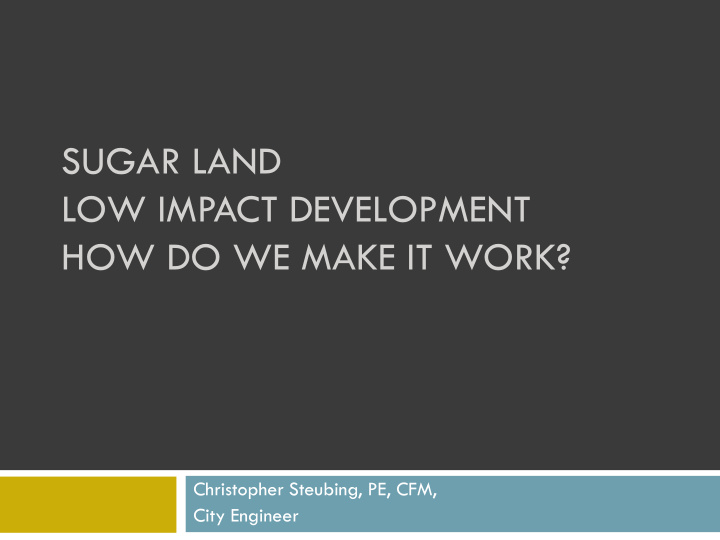



SUGAR LAND LOW IMPACT DEVELOPMENT HOW DO WE MAKE IT WORK? Christopher Steubing, PE, CFM, City Engineer
Sugar Land L.I.D. Environmental policy discussions Water quality a major concern Started in early 2000’s City’s conversion to surface water Limited direction Draft documents created / no formal direction LEED project consideration and discussion Created more questions than answers Left open ended Where do we go from here?
Sugar Land L.I.D. 2011 – Engineering started looking into LID standards – cautious approach 2012 – hired consultant to assist in the development of LID guidelines 2012 – Created staff based taskforce for QA/QC review and concurrence 2013 – Reviewed with Development Committee 2013 – Adopted by the City
Sugar Land L.I.D. City adopted LID as part of our Design Standards Chapter 10 – Low Impact Development & Green Infrastructure Design Criteria for Storm Water Management Updates managed by City Engineer Makes the criteria easier to update Used as supplement to existing standards Identified for site development and roadways
How Do We Make it Work? Through the adoption of LID standards Allows the design consultants more latitude Does allow for reduced detention over regular criteria Reduced impervious cover More natural areas Identifies runoff management functions and the effects
How Do We Make It Work? Identification of acceptable LID practices Defines and describes LID improvements that satisfy water quality and detention requirements Pre-Project Meeting Requirements Approved documentation process LID Design Criteria Soil amendments Vegetation considerations Rainwater harvesting Permeable pavement
How Do We Make It Work? Identified specific project types Roadways Commercial Developments Can expand as comfort level and knowledge of staff grows Maintenance Clearly identifying who is responsible Best practices Declaration (Appendix B)
How Do We Make It Work? Construction Training – Contractors, Inspectors and Vendors Communication Clear understanding of the design intent and unique details Erosion and sediment control SWPPP during construction Tree protection Construction sequencing
LID Development Activity Developing more interest Being utilized in City Parks Education of community ongoing Few development projects have used LID City continues to consider LID on future projects where it makes sense
Recommend
More recommend